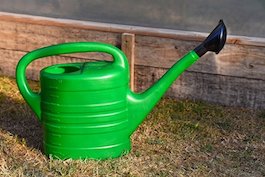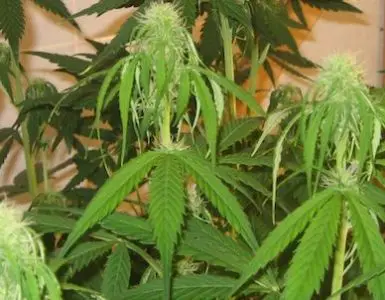Disclosure: As an Amazon Associate I earn from qualifying purchases. more info
Growing weed outdoors can be very beneficial, and certainly, more cost effective than setting up an indoor grow room. Natural sunlight, rain, and all of that fresh air naturally fuel outdoor weed plant growth.
That said, when growing pot outdoors, there are certain problems that can arise, such as pests, like grasshoppers. Today we want to talk about how to identify grasshopper damage, and most importantly how to keep grasshoppers off your pot plants.
There are actually a number of methods of controlling grasshopper populations and keeping them off your weed plants, the best methods include;
- Installing birdhouses close by.
- Buy praying mantis eggs.
- Use Spinosad.
- Use Neem oil.
- Use insecticidal soap.
- Use Floating row covers.
- Use Pyrethrin.
Contents
Identifying Grasshopper Damage on Marijuana Plants

The first step here is of course to identify the grasshoppers and the damage they are causing. When growing weed outdoors, if you see that the stems and leaves of your marijuana crop have large holes in them, grasshoppers might be to blame.
Of course, it’s easy to put 1 and 1 together, so if there is damage to your pot plants, and you see grasshoppers around, chances are almost 100% that they are to blame.
Not only will grasshoppers eat holes through leaves and stems, but they will actually eat whole leaves from front to back, and they can often chew straight through stems, thus irreparably damaging whatever is on the other side, or in other words, they can kill whole branches.
Grasshoppers have been known to completely destroy full weed plants.
Keeping Grasshoppers Off Pot Plants
Alright, so now you know that it’s the grasshoppers which are to blame for your damaged and half eaten weed plants. Now the problem you are faces with is choosing the right method to eliminate existing grasshoppers and to keep new ones from coming to the party.
Here is a list of ways to help keep grasshoppers off of your cannabis crop. Just before we get into it, many people attempt setting up a fine mesh fence around their weed plants to stop grasshoppers and other pests from getting to the weed plants.
However, grasshoppers can fly, quite well too, so a fence is rather useless. Luckily, there are a few other good ways of dealing with this grasshopper issue.
1. Install Bird Houses Close By
One of the best and most natural things that you can do is to install a variety of items that will attract birds around your weed crop.
This can include bird houses, bird perches, bird baths, and bird feeders too. Don’t worry about the birds choosing feeder food over grasshoppers either, because a live and fresh meal is always better than bird seed.
There are tons of predatory birds out there that will come to your aid, including hawks, sparrows, swallows, crows, falcons, mockingbirds, bluebirds, and a number of others all love eating live insects.
A juicy and meaty grasshopper is often a snack of choice for many birds. Try to ensure that you install bird houses or bird baths around the perimeter of your weed crop, so you have every angle covered.
2. Purchase Praying Mantis Eggs
Another thing you can do to help keep grasshoppers away from your outdoor weed plants is to go online and purchase some praying mantis egg sacks.
Yes, you will have to hatch them and make sure they stay alive, but this is not too hard to accomplish. Many people with grasshopper problems choose to go this route.
Praying mantises are carnivorous, strictly so, and they will not eat your weed plants, but they will certainly make quick work of grasshoppers. Having a couple dozen praying mantises standing guard over your weed plants is a great idea, and it’s also proven to be super effective.
Praying mantises are just as voracious of eaters as grasshoppers, with the only difference being that grasshoppers eat plants, whereas the mantises will eat the grasshoppers.
3. Spinosad
Spinosad is an organic and natural pesticide, one created through the fermentation of specific bacteria found in soil. The good part is that Spinosad is totally safe for plants, pets, and humans, and it’s organic and natural too.
Now, Spinosad based insecticides may not be quite as strong as some of the more chemical heavy options, but they do still work quite well, especially when applied liberally.
This stuff will kill grasshoppers on contact, and keep them away for a while too. On a side note, Spinosad is only effective for about 24 hours, so if using it, it does need to be applied to grasshoppers and whole pot plants, very liberally, and daily.
However, it is safe and natural, which is why many people choose to go with it. People often choose Spinosad because while it’s super toxic to grasshoppers, it won’t kill other animals, birds, or spiders, or in other words, animals that will lend you a helping hand by eating those pesky grasshoppers.
4. Neem Oil
Neem oil is super poisonous to most insects, and yes, this includes grasshoppers. There are many insecticidal sprays containing neem oil as well as many pure versions which you can mix with water and put in a sprayer at home.
This stuff will undoubtedly kill all grasshoppers, as well as most other insects that will harm your weed plants.
Moreover, it does kill on contact, and a single application can last for days, if not weeks. However, what you need to be aware of, for one, is that neem oil may be harmful to human health, especially in large quantities, although the research here is fairly limited.
Moreover, be careful to only spray soil, leaves, and stems, but not any buds.
Neem oil tastes and smells quite horrible, and it will leave your marijuana buds tasting like it, something you will notice when you go to smoke your homegrown crop.
5. Insecticidal Soap
There are plenty of insecticidal soaps out there that you can buy at gardening centers. We aren’t going to get into different brand names or ingredients here, but that said, there are tons of insecticidal soaps which use natural products.
These soaps, depending on the exact kind, should kill grasshoppers and most other insects that will damage your weed plants, plus they tend to be perfectly safe for people, kids, and pets too.
The only issue with these soaps is that they don’t last very long, and usually need to be applied daily to have any effect.
Yes, they will kill most grasshoppers within a few hours, but the soaps don’t stay on the plants for long.
6. Row Covers
Floating row covers are another option to go with. Now, this is kind of like a fence, but more like a mesh sheet that keeps insects at bay.
The problem with row covers is that you need to install posts to hold the covers up, which can be quite the issue once the weed plants start to get large, but it does work very well for smaller plants.
7. Pyrethrin
Similar to some of the above options, pyrethrin based options work as well. Pyrethrin will kill most pot pests on contact. Yes, it degrades quickly, so it needs to be applied often, but it works just fine.
BEWARE THAT PYRETHRIN WILL KILL BEES, AND THE WORLD IS EXPERIENCING A MASSIVE DECLINE IN BEE POPULATIONS, WHICH IS NOTHING SHORT OF DISASTROUS! SO ONLY USE THIS AS A VERY LAST RESORT!
Conclusion
Whatever elimination and control method you use to keep grasshoppers off plants, be sure to do it quickly. Grasshoppers multiply really fast and eat even faster, so identifying and eliminating the infestation as soon as humanly possible is crucial to the survival of your marijuana crop.





